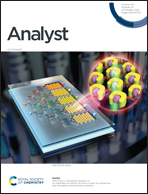Non-contact vapor detection of illicit drugs via atmospheric flow tube-mass spectrometry†
Abstract
Real-time, non-contact detection of illicit drugs is a desirable goal for the interdiction of these controlled substances, but the relatively low vapor pressures of such species present a challenge for trace vapor detection technologies. The introduction of atmospheric flow tube-mass spectrometry (AFT-MS), which has previously been demonstrated to detect gas-phase analytes at low parts-per-quadrillion levels for explosives and organophosphorus compounds, also enables the potential for non-contact drug detection. With AFT-MS, direct vapor detection of cocaine and methamphetamine from ∼5 μg residues at room temperature is demonstrated herein. Furthermore, thermal desorption of low- to sub-picogram levels of cocaine, methamphetamine, fentanyl, and heroin is observed via AFT-MS using a carrier flow rate of several L min−1 of air. These low levels can permit non-contact sampling through collection of vapor, effectively preconcentrating the analyte before desorption and analysis. Quantitative evaluation of the thermal desorption approach has yielded limits of detection (LODs) on the order of 10 fg for cocaine and fentanyl, 100 fg for methamphetamine, and 1.6 pg for heroin. The LOD for heroin was lowered to 300 fg by using tributyl phosphate as a dopant to form a proton-bound heterodimer with heroin. When used with AFT-MS, the intentional formation of specific drug-dopant adducts has the potential to enhance detection limits and selectivity of additional drug species. Species that are prone to form adducts present a challenge to analysis, but that difficulty can be overcome by the intentional addition of a dopant. Molecules unlikely to form adducts will remain essentially unimpacted, but the adduct-forming species will interact with the dopant to compress the analyte signal into a single peak. This approach would be valuable in the application of non-contact screening for illicit substances via vapor collection followed by thermal desorption for analysis.



 Please wait while we load your content...
Please wait while we load your content...